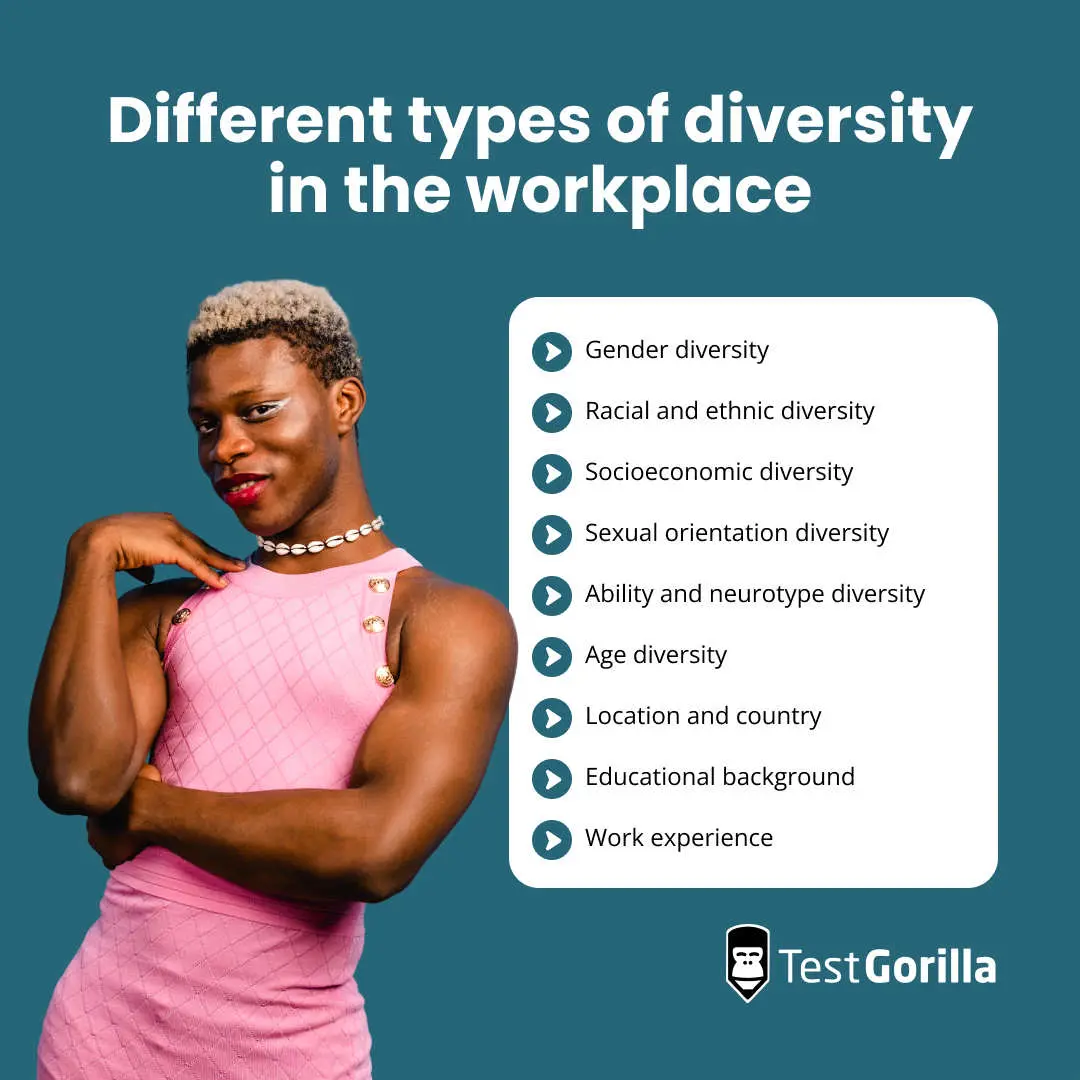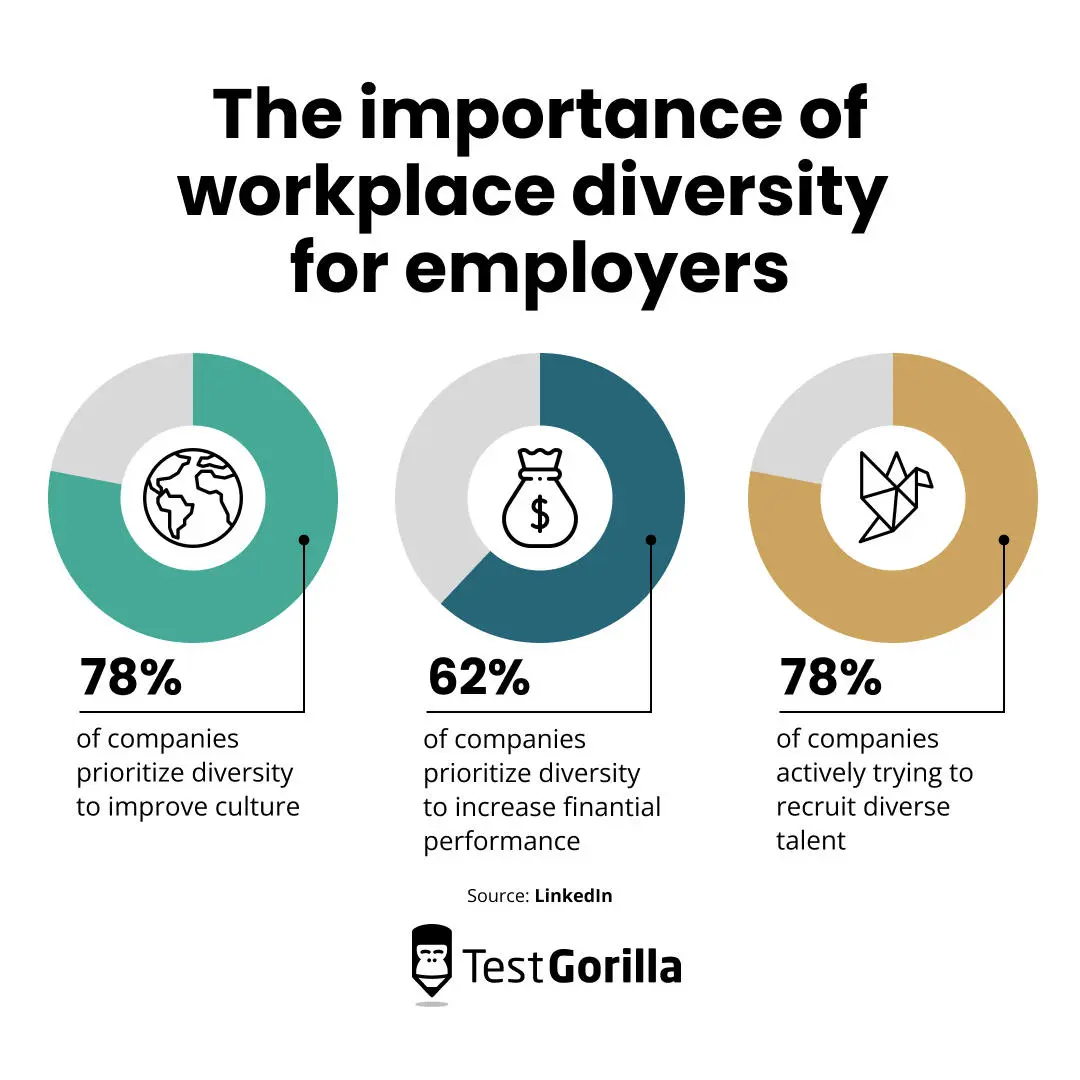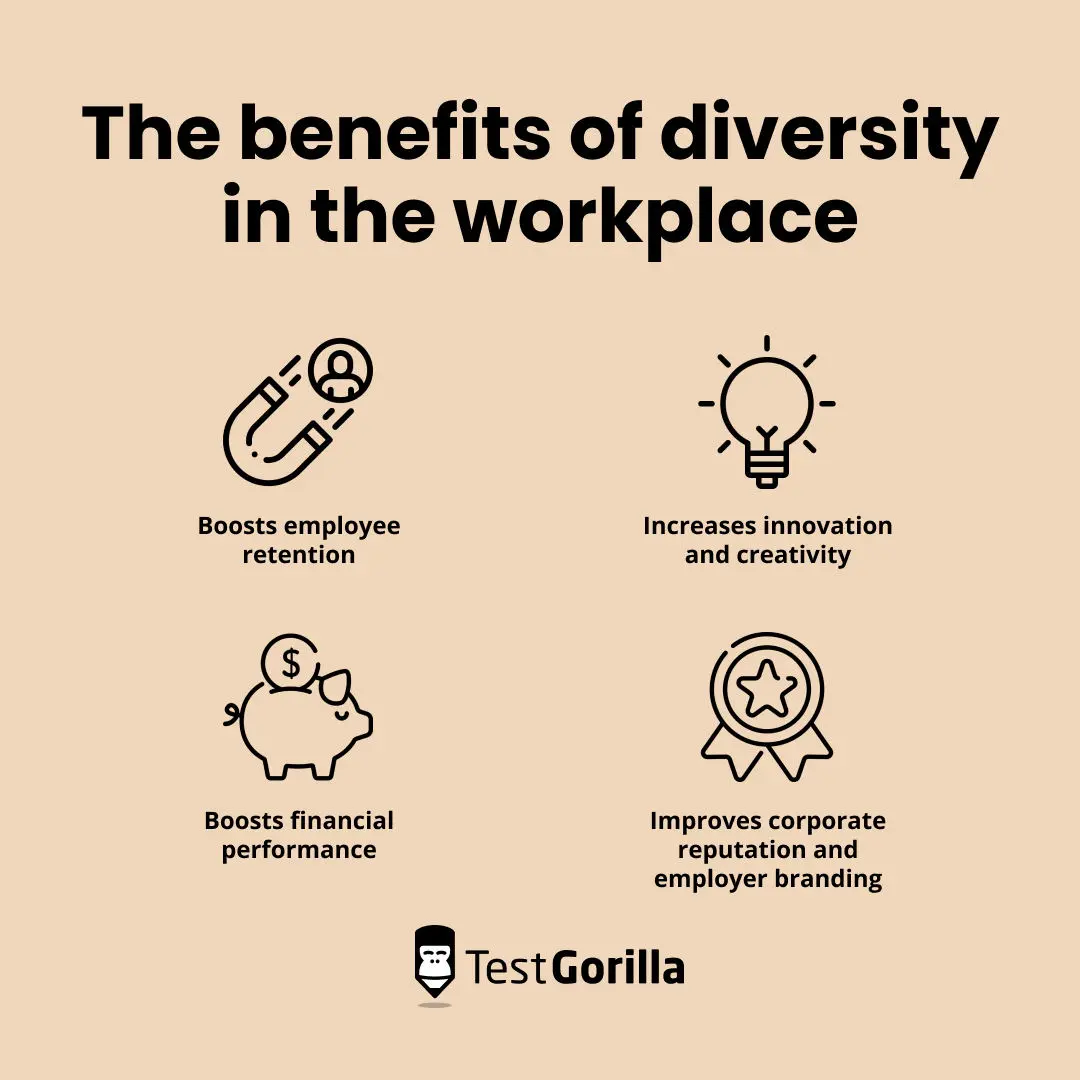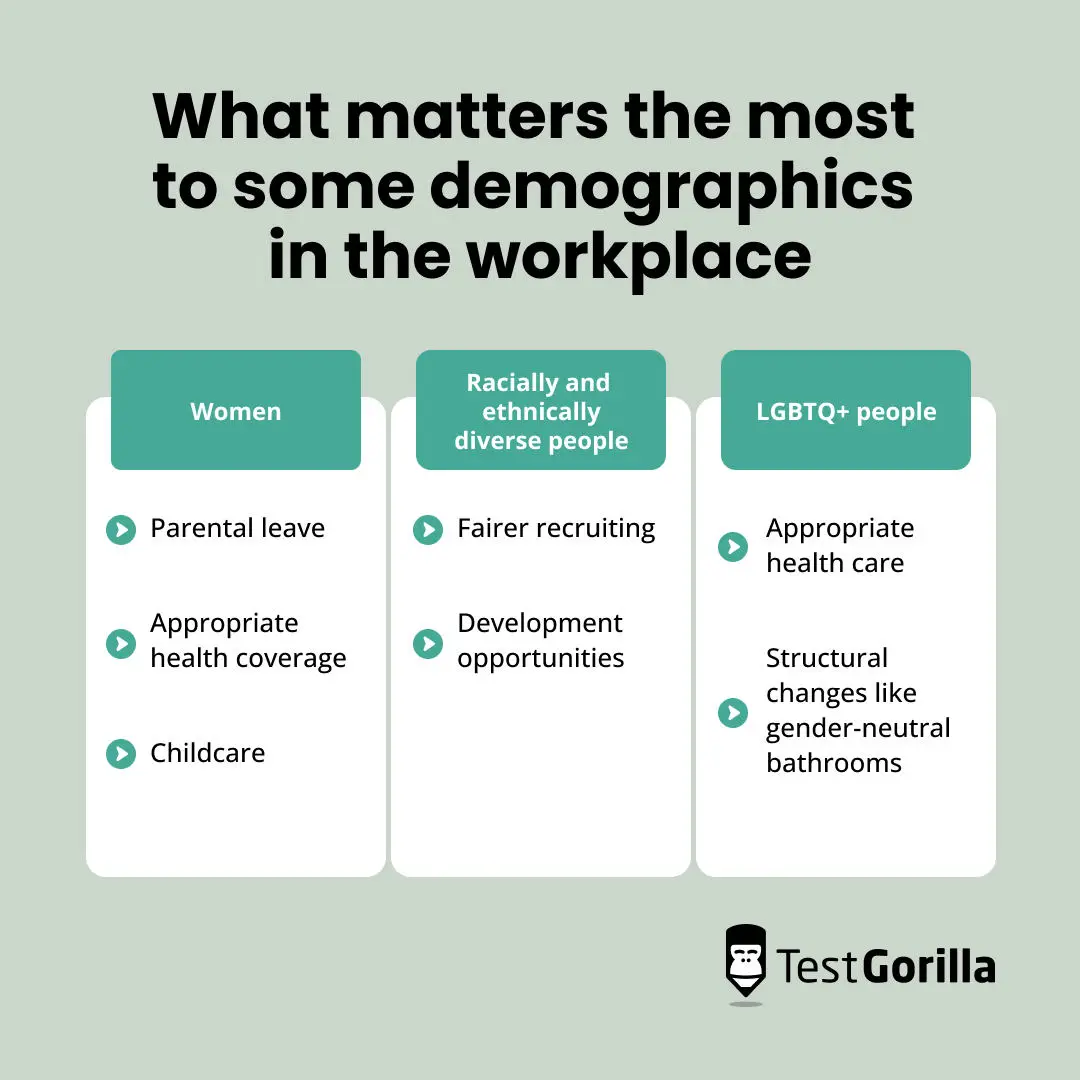Diversity in the workplace is an emerging talent retention strategy with a myriad of related benefits, including increased innovation and problem-solving.
Moreover, not only underrepresented groups need a workplace where they can feel accepted and safe – nearly 80% of American employees want to work for a company that values diversity and inclusion.[1]
Because workplace diversity is essential for an efficient, happy workforce, you should go beyond setting DE&I targets and take action to build an inclusive culture.
This blog discusses the importance and benefits of a diverse workforce and then focuses on how diversity impacts employee retention.
Table of contents
- What is diversity in the workplace?
- Why is diversity important in the workplace?
- The benefits of diversity in the workplace
- 7 best practices for leveraging workplace diversity to retain your best performers
- 3 examples of companies succeeding with diversity in the workplace as a talent retention strategy
- Help diversity in the workplace thrive with talent assessments
What is diversity in the workplace?
Diversity generally refers to including people of different backgrounds, cultures, and life experiences in a group.
Diversity in the workplace refers to bringing this variety of cultures, genders, races, backgrounds, and skills into an organization's workforce.
It’s a common misconception that diversity in the workplace refers to a group of “diverse-looking” people, and this notion causes many of the challenges of diversity in the workplace.
The concept isn’t entirely wrong, but there’s a lot more to diversity and inclusion in the workplace.
Properly leveraging diversity helps you stay on top of important employee retention trends.
Real diversity is people with unique qualities, including unseen things like religious beliefs and disabilities.
Diversity extends past gender identity and ethnicity. For example, diversity of thought in the workplace may refer to neurodivergent employees or workers from a small, rural community working in a big city.
The sky’s the limit regarding diverse opinions, perspectives, and lifestyles. Diversity in the workplace includes “that one employee” who doesn’t join happy hour because they don’t drink.
On that note, let’s quickly cover the various types of diversity in the workplace.
Different types of diversity in the workplace
There are countless ways to have a diverse workplace. Any person with a different opinion, thought, belief, lifestyle, or physical trait is part of diversity.
Here are a few of the most common diversity in the workplace examples:
Gender diversity
Racial and ethnic diversity
Socioeconomic diversity
Sexual orientation diversity
Ability and neurotype diversity
Age diversity
Location and country
Educational background
Work experience
Let’s quickly touch on those last two points.
Many people don’t automatically understand why education and work experience are important aspects of diversity. After all, they’re simply a requirement for most jobs.
In truth, most jobs don’t require the degrees and extensive work history we put on the job description. Unique work backgrounds and education are diverse qualities that add their benefits and challenges to a workplace.
It’s also important to remember other forms of diversity commonly omitted from our thoughts, such as age and neurodiversity.
These qualities help a workplace flourish. A company with rich generational diversity benefits from knowledge sharing and several generations’ perspectives.
Remembering these points is crucial for the future because if you want to build a truly diverse workforce, you must understand all the facets of diversity.
Why is diversity important in the workplace?
Because of social issues and the march of progress, organizations are realizing two key points:
Employees and customers alike want equal treatment and representation
A diverse workforce brings powerful advantages, like increased financial performance and innovation
Many organizations are learning how to promote diversity and inclusion in the workplace because it benefits their culture and creates a better sense of belonging, reducing the employee attrition rate.
Here are a few statistics showing the importance that companies place on workplace diversity:
78% of companies are prioritizing diversity to improve company culture
62% are doing it to increase financial performance
78% of employers are actively trying to recruit diverse talent[2]
For many companies, diversity programs in the workplace are common and have been for some time. However, many sectors, such as engineering, flight, and construction, still struggle. Many industries have room for improvement; getting started is well worth your investment.
Here’s a quick look at why a diverse workforce is important to employers:
Identifies new fixes and approaches: Diversity boosts innovation, helping visualize, find new approaches, and solve problems. It also contributes to a culture of learning which encourages career growth.
Improves collaboration and teamwork: Promoting diversity and diverse thoughts makes people more likely to share their opinions and feel more comfortable in a team setting, improving working relationships.
Helps you cater to new and different customer bases: A diverse workforce helps you serve different customers better, opening perspectives to new expectations and needs.
Boosts cultural competence and global business performance: Diverse workers open your perspectives to new cultures and customs, building better comprehension of international businesses.
Decreases groupthink: Groupthink is when people avoid sharing unique perspectives, expressing doubt, or disagreeing with others. It’s common in homogeneous workplaces. A diverse workforce reduces the chance of groupthink.
Let’s quickly touch on that last point.
Groupthink often happens in environments with little to no psychological safety. These workplaces usually penalize or ridicule employees who ask questions, challenge the status quo, or make mistakes.
However, these actions are required to innovate and build new processes.
Psychological safety is non-negotiable for every workplace and crucial to building an inclusive organization.
Ensuring psychological safety is one of the main reasons why diversity, equity, and inclusion in the workplace are major employee benefits.
Building an inclusive workplace increases engagement and a sense of belonging, creating a better employee experience.
The benefits of diversity in the workplace
The impact of diversity in the workplace is impressive. Numerous studies have shown that a diverse workforce contributes significantly to retention, innovation, and business performance. Let’s look at the top four benefits of workplace diversity.
Bookmark this deep-dive article for later if you’d like to explore even more advantages of workplace diversity.
1. Boosts employee retention
Workplace diversity creates a healthier, happier workforce.
When an organization intentionally fosters diversity, it builds a work environment where employees want to be.
Gen Z, the latest working generation, needs to see active work toward diversity to consider a company a great place to work:
31% of Gen Z workers want to work for a company that proactively prioritizes diversity and inclusion in the workplace
32% would not work for a company that didn’t seek to close the gender pay gap
30% would not work for a company that didn’t have a diverse workforce[3]
If you want to attract and retain Gen Z employees, who are the future of the workforce, you need to prioritize a diverse workplace.
Further, diversity helps employee engagement. Employees who are satisfied with their organization’s commitment to diversity are twice as engaged as dissatisfied employees, which is a key element in retention.
Employee engagement, in turn, helps boost your employee retention rate.
A Gallup study found that highly engaged employees are less likely to actively search for a new job.
A diverse workplace creates a healthy sense of belonging that employees need to feel accepted, heard, and comfortable. Providing that builds a place that employees want to be a part of for a long time.
2. Increases innovation and creativity
New and different perspectives boost innovative thinking. Further, we’ve seen that workplace diversity decreases groupthink, which directly affects creativity, problem-solving, and healthy disagreements that lead to better outcomes.
After all, if your employees feel pressured to all be the same and hold the same opinions, your company doesn’t hear many new ideas.
Building an inclusive culture – especially one where employees feel empowered to speak up and be their authentic selves – enables leaders to be surrounded by skilled people who can identify areas for improvement and opportunity.
According to one study, companies with more diverse leadership teams report higher innovation revenue – 45% of total revenue versus the usual 26%.[4]
3. Improves corporate reputation and employer branding
When companies take time and effort to address diversity correctly, it improves corporate reputation and employer branding.
As we saw, more than a third of Gen Z employees want to work for diversity-minded companies. The right diversity initiatives in the workplace help create solid employer branding.
Your employer branding is essentially your reputation as a great employer. However, your standard corporate reputation also stands to gain a lot from embracing diversity in the workplace.
These two factors are the main drive behind a good CSR strategy.
Showing your employees, customers, candidates, and partners that you’re accountable for important matters like diversity and inclusion gives you a firm footing in the working world.
4. Boosts financial performance
The impact of diversity in the workplace doesn’t stop at increased innovation – it also shows in the bottom line.
Owing to increased innovation, creativity, and engagement, employees perform better, which leads to better financial outcomes.
One study found that gender-diverse teams are 25% more likely to financially outperform less diverse teams, and the same applies to ethnically diverse teams, which are 36% more likely to come up ahead.
Cultural diversity in the workplace leads to having a range of thoughts and opinions that drive better decision-making, leading to better ideas and a better use of resources.
When you leverage workplace diversity, you gain more unique ideas from hundreds of more sources, which helps your business thrive and grow.
7 best practices for leveraging workplace diversity to retain your best performers
Managing diversity in the workplace can be tricky, but it’s worth the time and effort.
Fostering a diverse workforce builds a positive culture that reduces your employee turnover rate and improves your company.
Let’s check out the main strategies for building and maintaining a diverse workplace.
Strategies for building a diverse workplace: A summary
Strategies | What it accomplishes |
1. Adopt inclusive hiring practices | Reduces barriers and helps promote a more diverse talent pool |
2. Create an inclusive workplace for everyone | Ensures every member of your staff feels welcome and safe |
3. Support your people specifically | Provides your employees with support where they need it rather than assuming what they need |
4. Adopt diversity and inclusion as core company values | Weaves diversity into your entire company and everything it does, rather than just a few token gestures |
5. Encourage inclusive leadership | Gives your company a foundation of inclusivity and shows employees that leaders care about diversity |
6. Set up employee resource groups | Supplies people with important resources and a space to share their experiences |
7. Implement diversity training programs | Educates employees on diversity and creates better understanding, which nurtures an inclusive environment |
1. Adopt inclusive hiring practices
Workplace diversity starts with the hiring process, so it’s imperative that your recruitment is inclusive and considers diverse practices.
Inclusive hiring practices are recruiting processes that reduce barriers to entry and even the playing field, such as removing unnecessary job requirements and assessing skills without bias.
Here are a few examples of inclusive hiring practices:
Talent assessments
Inclusive language in job descriptions
No unnecessary requirements (i.e., college degrees for positions that don’t require them)
Structured interviews
Different candidate sourcing channels
These recruitment practices naturally increase diversity without forced initiatives like diversity targets. These processes ensure that each candidate has the same chances, regardless of background, race, gender, or age.
For example, when you gauge an older candidate with talent assessment tests, they don’t have to submit a resume filled with opportunities for bias, such as work and graduation dates.
These processes create equal ground for all job seekers and, at the same time, ensure you’re hiring the right people.
2. Create an inclusive workplace for everyone
Managing diversity in the workplace is a key part of nurturing diversity and inclusion. It isn’t enough to hire diverse people. You also need to supply them with a positive, accepting environment.
Work needs to be accessible and inclusive for everyone.
Here are a few diversity and inclusion in the workplace examples:
Ensure that religious employees have spaces to prepare food according to their beliefs and to complete their daily prayers
Make sure that disabled employees have access to accommodations, like flexible work
Ensure that LGBTQ+ employees have access to gender-neutral bathrooms
Your organization needs to be a safe space for everyone to be truly inclusive.
It’s also important to ensure that learning and development opportunities are inclusive and available to everyone. To learn more about this subject, read our blog on internal mobility.
3. Support your people specifically
There isn't just one way to be inclusive – the essence of diversity is that everyone is different, meaning your diverse workplace has different needs than other workplaces.
Ask your people to discover what they specifically need and take action to ensure they get support.
For example, some demographics have commonalities in their workplace needs. One study found that certain demographics had particular diversity measures that mattered most to them:
Women: Parental leave, appropriate health coverage, childcare
Racially and ethnically diverse people: Fairer recruiting and development opportunities
LGBTQ+ people: Appropriate health care, structural changes like gender-neutral bathrooms
Reports like this help you understand different demographics, but the best way is to ask your people directly through employee surveys and one-on-one meetings.
You can discover what your people need by encouraging upward feedback. This act also promotes psychological safety by building an environment where people can share their opinions without fear.
For more information about supporting workers, read our piece on mental health in the workplace.
4. Adopt diversity and inclusion as core company values
Too many organizations make the mistake of discussing diversity and inclusion without acting on it. People say “show, don’t tell,” and that goes for diversity, too.
Adopt diversity and inclusion as core values and implement related practices throughout your company.
Your organization must take a stance against discrimination, adopt inclusive hiring practices, offer accommodations, and speak out on social issues.
Inclusive companies can’t stay silent about important events and try to “remain neutral.”
Another important aspect of adopting diversity as a core value is using inclusive language throughout your organization. Use “parental leave” instead of “maternal leave,” and put your pronouns in your email signature.
These practices create a place where diversity and inclusion can thrive and increase trust in the workplace.
An important element in adopting diversity to your core is having inclusive leadership. So, let’s look at that next.
5. Encourage inclusive leadership
A company’s leaders play a crucial role in every process, encouraging the right culture and steering the company in the right direction.
To adopt diversity and inclusion in the workplace, you must get leadership on board.
Encourage leaders to be open about their stance on diversity and inclusion. Employees need to know that company leadership supports them, as do candidates applying to your organization.
Promote leadership communication, especially about sensitive topics like social issues and events. One of the best ways to show your stance on inclusivity is by having the courage to follow your convictions even during difficult times.
It’s also a good idea to commit your company to getting more diverse people in leadership positions.
When you have access to the best-skilled employees because you consistently assess their skills, representation is a key motivator for your workforce.
For example, encouraging more women to join upskilling programs leads to more female leaders in the future.
6. Set up employee resource groups
Employee resource groups (ERGs) are employee-led networks that promote inclusivity and are a safe space for underrepresented groups.
They help different groups of people get together, share, and feel supported at work. They also help them connect with allies, which is crucial to building strong working relationships.
Common ERGs include:
Women
Black people
Hispanic people
LGBTQ+ people
Asia and Asia Pacific people
Veterans
These groups typically have thoughtful discussions, hold meaningful events, and help coordinate organizational diversity initiatives.
ERGs give employees a space to share their experiences with similar people and establish your company as a diverse workplace, improving your employer branding and telling prospective candidates your stance before they even apply.
7. Implement diversity training programs
Diversity training is an employee training program designed to increase awareness and understanding of diverse people.
Training reduces unconscious bias, stereotyping, and microaggressions. There are many different types of diversity training programs, including:
Instructor-led courses
Webinars
Microlearning
Mobile learning
Gamification
Although there are many ways to deliver them and many courses, diversity training programs build an inclusive mindset and create a more accepting atmosphere.
We recommend you monitor and measure your progress throughout. Remember that employee coaching is essential to discuss the results with your people – tell them where they’re doing great and where they need improvement.
For our full guide on the topic, read our article on diversity training.
3 examples of companies succeeding with diversity in the workplace as a talent retention strategy
Diversity, equity, and inclusion in the workplace are crucial for a well-functioning, happy workforce, and these companies know it.
Here’s a look at three diverse companies that effectively leverage workplace diversity.
Companies succeeding with workplace diversity: A summary
Company | Why it’s successful |
1. Marriott | Commits to cultural diversity and supporting its international employees |
2. Kaiser Permanente | Supports an environment of psychological safety for its people |
3. Accenture | Measures its progress and holds leaders accountable |
Marriott
Marriott, a brand of full-service hotels and resorts, is committed to transparency and open communication about diversity.
This company has diversity and inclusion as core values. It understands that employee wellbeing and cultural diversity in the workplace are critical to its success as a global hospitality company.
Marriott has three major diversity initiatives:
UNITY: An inclusive initiative that supports the recruitment, retention, and advancement of every worker
TakeCare: A program designed to engage different cultures through community and purpose
TakeCare Relief Fund: A subset of TakeCare that provides financial assistance to any employee working at a Marriott International location who’s facing financial hardship[5]
This company also offers reasonable accommodations to its disabled employees.[6]
How has this strategy panned out for the hospitality giant?
Marriott is in the top 35% of similar-sized companies in its ability to retain quality employees, and 73% of its employees are excited to go to work.
Kaiser Permanente
Kaiser Permanente, a managed care organization, believes diverse perspectives are essential to achieving its organizational goals.
This company has three important DE&I core values:
Inclusion: Every employee should feel safe sharing ideas, concerns, and their identities without fear
Accountability: Each person is responsible for the actions or inaction that could harm another
Advocacy: Each employee advocates for diversity and inclusion for everyone and amplifies the voices of others
Kaiser Permanente shows these core values through various practices, including its inclusive hiring and bias training.
As far as diversity metrics in the workplace, it has some impressive demographics:
74% of its staff are women
69% are ethnic, racial, and cultural minorities[7]
This workplace diversity makes Kaiser Permanente a great place to work, scoring 73 out of 100 for employee retention.[8]
Accenture
Accenture, a professional services company, believes the key to reinvention and innovation is diverse backgrounds, perspectives, and lived experiences.
This company prizes diversity of thought in the workplace, which drives its talent strategy by using a diverse hiring panel and recruiting sources.[9]
To achieve its excellent diversity and inclusion, it follows this process:
Establish diversity goals and share them publicly
Collect HR analytics to measure progress
Work to continuously improve
Hold leaders accountable for ensuring that it retains innovative and talented people[10]
These practices have made Accenture a highly attractive company to work for.
It’s within the top 10% of similar-sized companies in its ability to retain quality employees. More than 70% of employees would not leave if offered more money, and 80% are excited to go to work each day.[11]
Help diversity in the workplace thrive with talent assessments
Learning how to promote diversity in the workplace is one of the best employee retention strategies you can leverage.
This tactic fosters an inclusive workplace where diverse employees want to come to work and aren’t afraid to refer professionals in their circle.
Adopt diversity as a core value and work to spread it to every corner of your organization.
To do so, use inclusive hiring practices, support your people with employee resource groups, and nurture a healthy culture.
For more information on this topic, read our article on how to foster an inclusive culture.
If you’re interested in browsing our talent assessments, a key element in diversity hiring, check out our test library.
Sources
1. Caminiti, Susan. (April 30, 2021). "Majority of employees want to work for a company that values diversity, equity and inclusion, survey shows". CNBC. Retrieved November 22, 2023. https://www.cnbc.com/2021/04/30/diversity-equity-and-inclusion-are-important-to-workers-survey-shows.html
2. "LinkedIn 2018 Report Highlights Top Global Trends in Recruiting". (January 10, 2018). LinkedIn Pressroom. Retrieved November 22, 2023. https://news.linkedin.com/2018/1/global-recruiting-trends-2018
3. Leigh, Steve. (January 16, 2022). “What Do Gen Z Want from Employers?”. Sensu. Retrieved November 25, 2023. https://sensuinsight.com/what-do-gen-z-want-from-employers/
4. Lorenzo, Rocío, et al. (January 23, 2018). "How Diverse Leadership Teams Boost Innovation". BCG. Retrieved November 22, 2023. https://www.bcg.com/en-us/publications/2018/how-diverse-leadership-teams-boost-innovation
5. Selin, Julia. (March 2022). "More than Just a Workplace: A Case Study of Diversity, Equity, and Inclusion in Marriott International Inc. Hotels". Digital Commons. Retrieved November 22, 2023. https://digitalcommons.calpoly.edu/cgi/viewcontent.cgi?article=1026&context=expindsp
6. "Diversity & Inclusion". Marriott International. Retrieved November 22, 2023. https://www.marriott.com/diversity/diversity-and-inclusion.mi
7. "A workplace for all". Kaiser Permanente. Retrieved November 22, 2023. https://about.kaiserpermanente.org/commitments-and-impact/equity-inclusion-and-diversity/a-workplace-for-all
8. "Kaiser Permanente Retention Score". Comparably. Retrieved November 22, 2023. https://www.comparably.com/companies/kaiser-permanente/retention
9. "Making underrepresented communities feel included". (June 20, 2022). Accenture. Retrieved November 22, 2023. https://www.accenture.com/in-en/insightsnew/inclusion-diversity/vaahini-making-underrepresented-communities
10. "Our commitment to inclusion & diversity". Accenture. Retrieved November 22, 2023. https://www.accenture.com/us-en/about/inclusion-diversity-index
11. "Accenture (Global) Retention Score". Comparably. Retrieved November 22, 2023. https://www.comparably.com/companies/accenture-global/reten
Related posts
Hire the best candidates with TestGorilla
Create pre-employment assessments in minutes to screen candidates, save time, and hire the best talent.
Latest posts
The best advice in pre-employment testing, in your inbox.
No spam. Unsubscribe at any time.

Hire the best. No bias. No stress.
Our screening tests identify the best candidates and make your hiring decisions faster, easier, and bias-free.
Free resources
This checklist covers key features you should look for when choosing a skills testing platform
This resource will help you develop an onboarding checklist for new hires.
How to assess your candidates' attention to detail.
Learn how to get human resources certified through HRCI or SHRM.
Learn how you can improve the level of talent at your company.
Learn how CapitalT reduced hiring bias with online skills assessments.
Learn how to make the resume process more efficient and more effective.
Improve your hiring strategy with these 7 critical recruitment metrics.
Learn how Sukhi decreased time spent reviewing resumes by 83%!
Hire more efficiently with these hacks that 99% of recruiters aren't using.
Make a business case for diversity and inclusion initiatives with this data.





















